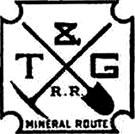Millers
The location which would become Millers began as Desert Wells Station around 1866 on the road between San Antonio and Silverpeak, and after 1901 as a water stop on the Sodaville-Tonopah road. In 1904, with the construction of the Tonopah Railroad (soon the Tonopah & Goldfield), it became known as Millers after the vice president of the Tonopah Mining Company. Its significance grew in 1906 when the Desert Power & Milling Company erected a 100-stamp mill to treat ore for the Tonopah Mining Co., powered by a coal steam power plant. The following year, another sixty-stamp mill was completed by the Tonopah-Belmont Development Company, and new repair shops were built to support the T&G. Millers was envisioned to become the world's largest ore shipment center, with railroad lines planned to connect to camps as far away as Austin.
Though these plans were never realized, Millers did grow to a population of around 250, with its own business district and a large park with baseball diamond and grand stands. The town prospered through the end of the decade, however several factors led to its swift decline. The T&G shops were dismantled and moved to Goldfield in 1910, followed by the completion of the Tonopah-Belmont Co.'s new mill in Tonopah in 1912. The Desert mill was used again briefly in the 1920s, and old tailings were worked by various lessees over the years, but Millers never recovered. The T&G was finally discontinued in 1947.



























































